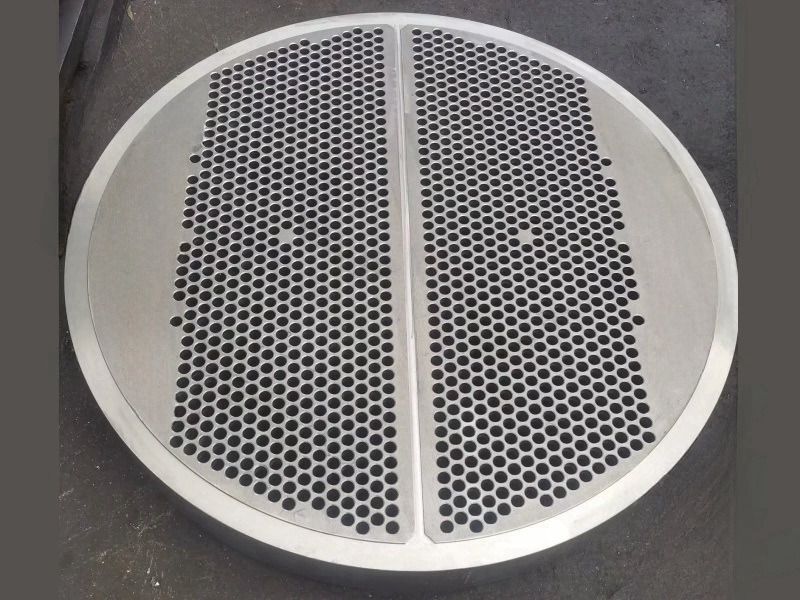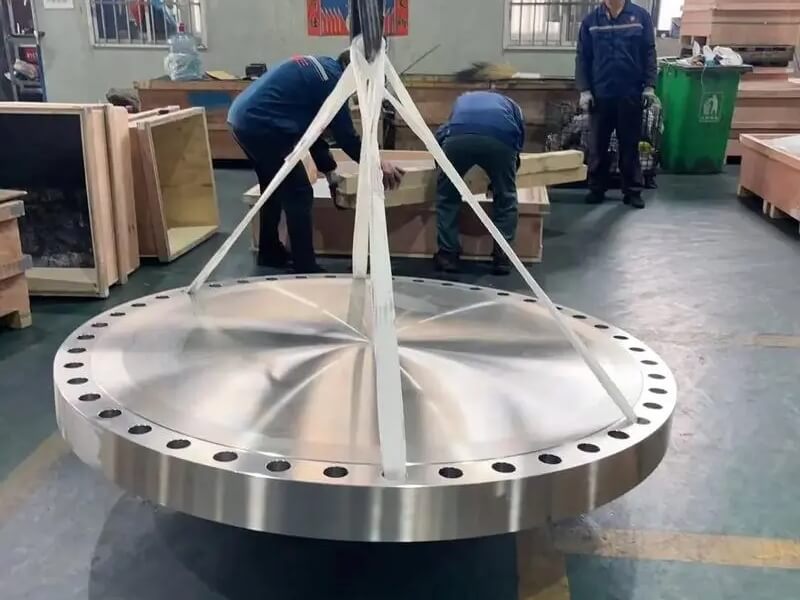904L tube sheets and 904L flanges
904L alloy steel has the following characteristics:
904L is a highly alloyed austenitic stainless steel with low carbon content. This steel is designed for environments with harsh corrosion conditions. Initially, this alloy was developed for corrosion resistance in dilute sulfuric acid. This feature has been proven to be very successful through years of practical application. 904L has been standardized in many countries and has been approved for use in the manufacture of pressure vessels. 904L alloy, like other commonly used CrNi austenitic steels, has good resistance to pitting and crevice corrosion, high resistance to stress corrosion cracking, good resistance to intergranular corrosion, good processability, and weldability. The maximum heating temperature during hot forging can reach 1180 degrees Celsius, and the minimum stop forging temperature is not less than 900 degrees Celsius. This steel can be hot formed at 1000-1150 degrees Celsius. The heat treatment process of this steel is 1100-1150 degrees Celsius, and it is rapidly cooled after heating. Although this steel can be welded using universal welding processes, the most appropriate welding methods are manual arc welding and tungsten inert gas arc welding. When using manual arc welding to weld plates with a diameter not exceeding 6mm, the diameter of the welding rod shall not exceed 2.5mm; When the plate thickness is greater than 6 millimeters, the diameter of the welding rod is less than 3.2 millimeters. When heat treatment is required after welding, it can be done by heating at 1075-1125 degrees Celsius and then rapidly cooling. When using tungsten inert gas arc welding, the filler metal can be used with the same welding rod. After welding, the weld seam must be pickled and passivated.
904L metallographic structure
904L is a completely austenitic structure, and compared to austenitic stainless steels with high molybdenum content, 904L is not sensitive to the precipitation of ferrite and alpha phase.
Corrosion resistance of 904L
Due to the low carbon content of 904L (maximum 0.020%), there will be no carbide precipitation under general heat treatment and welding conditions. This eliminates the risk of intergranular corrosion that occurs after general heat treatment and welding. Due to its high chromium nickel molybdenum content and the addition of copper, 904L can be passivated even in reducing environments such as sulfuric acid and formic acid. The high nickel content results in a lower corrosion rate even in the active state. In pure sulfuric acid with a concentration range of 0-98%, the usage temperature of 904L can reach up to 40 degrees Celsius. In pure phosphoric acid with a concentration range of 0-85%, its corrosion resistance is very good. Impurities have a strong impact on the corrosion resistance of industrial phosphoric acid produced by wet process technology. Among all types of phosphoric acid, 904L has better corrosion resistance than ordinary stainless steel. In highly oxidizing nitric acid, 904L has lower corrosion resistance compared to high alloyed steel grades without molybdenum. In hydrochloric acid, the use of 904L is limited to lower concentrations of 1-2%. Within this concentration range. The corrosion resistance of 904L is better than that of conventional stainless steel. 904L steel has high resistance to pitting corrosion. Its resistance to crevice corrosion is also very good in chloride solutions. The high nickel content of 904L reduces the corrosion rate in pits and crevices. Ordinary austenitic stainless steel may be sensitive to stress corrosion in an environment rich in chloride at temperatures above 60 degrees Celsius. By increasing the nickel content of the stainless steel, this sensitization can be reduced. Due to its high nickel content, 904L exhibits high resistance to stress corrosion cracking in chloride solutions, concentrated hydroxide solutions, and environments rich in hydrogen sulfide.
904L Tube sheet
A 904L tube sheet is a component used in various industrial applications particularly in heat exchangers and condensers. The 904L stainless steel tube sheet is specifically chosen for its superior resistance to aggressive environments, such as those containing sulfuric acid, phosphoric acid, and chloride solutions. It offers exceptional resistance to pitting, crevice corrosion, and stress corrosion cracking, making it highly suitable for applications in the chemical, petrochemical, and offshore industries. The use of 904L stainless steel tube sheets ensures the long-term reliability and performance of heat transfer equipment. Its corrosion resistance properties allow for extended service life and reduced maintenance requirements, resulting in cost savings and enhanced operational efficiency. Choose 904L tube sheets for superior corrosion resistance and reliable performance in demanding environments. Experience the benefits of this high-quality stainless steel alloy for your heat exchangers and condensers.

904L flange
904L flanges are commonly used in industries such as chemical processing, petrochemical, pharmaceutical, and offshore applications. Their resistance to corrosion makes them suitable for handling corrosive fluids and gases. Additionally, 904L flanges offer excellent strength, durability, and weldability, making them a reliable choice for critical applications. The use of 904L flanges can help ensure the integrity and longevity of piping systems by providing a robust and corrosion-resistant connection. They are available in various types, including slip-on, weld neck, blind, and threaded flanges, to suit different installation requirements. In summary, 904L flanges are specifically made from 904L stainless steel, which offers superior corrosion resistance in demanding environments. Their use can enhance the reliability and performance of piping systems, making them ideal for applications where corrosion resistance is paramount.

904L application areas:
904L alloy is a versatile material that can be applied in many industrial fields:
1. Petroleum and petrochemical equipment, such as reactors in petrochemical equipment.
2. Storage and transportation equipment for sulfuric acid, such as heat exchangers.
3. The flue gas desulfurization device in power plants is mainly used in the tower body, flue, door panels, internal components, spray systems, etc. of the absorption tower.
4. Scrubbers and fans in organic acid treatment systems.
Similar grades
| GB/T | UNS | AISI/ASTM | ID | W.Nr |
|
00Cr20Ni25Mo4.5Cu |
N08904 | 904L | F904L | 1.4539 |
904L chemical composition
|
C |
Si | Mn | P | S | Cr | Ni | Mo | Cu | Fe |
|
0.02 |
1 | 2 | 0.045 | 0.035 | 19-23 | 23-28 | 4-5 | 1-2 |
Mechanical properties
| Tensile strength | Yield Strength | Elongation | Density | Melting point |
| RmN/mm | Rp0.2N/mm | A5% | 8.0g/cm3 | 1300-1390℃ |
Wuxi Changrun has provided high-quality tube sheets, nozzles, flanges, and customized forgings for heat exchangers, boilers, pressure vessels, etc. to many well-known petrochemical enterprises at home and abroad. Our customers include PetroChina, Sinopec, Chevron, Bayer, Shell, BASF, etc. Send your drawings to sales@wuxichangrun.com We will provide you with the best quotation and the highest quality products.
